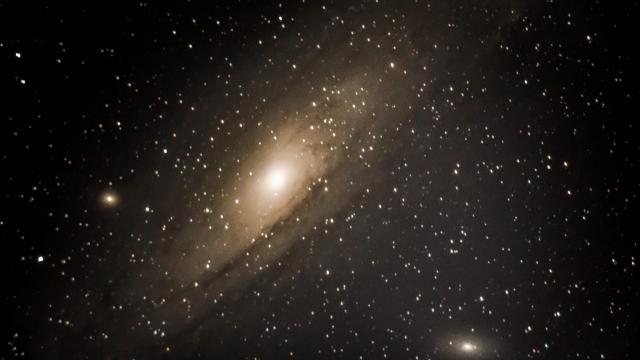A team of astrophysicists believe that a glob of stars in our next-door galaxy is hiding an intermediate-mass black hole, a type predicted to exist but that has never been observed for certain.
The globular cluster in question is called B023-G078, and it’s situated on the outskirts of the Andromeda Galaxy, about 2.5 million light-years away. The researchers believe the cluster, which contains the mass of 6.2 million Suns, is actually a stripped nucleus: the remains of several small galaxies that glommed together. And the centre of this galactic mish-mash is an intermediate-mass black hole (IMBH), say researchers in a paper published in The Astrophysical Journal.
“The most interesting thing about this IMBH is its location — it is in a massive star cluster around Andromeda that we think is actually the core of a former dwarf galaxy whose outskirts were stripped away by Andromeda’s gravity,” said Anil Seth, an astrophysicist at the University of Utah and a co-author of the recent paper, in an email to Gizmodo. “Based on previous work in higher mass stripped nuclei, simulations, and this work, it seems like these stripped galaxy nuclei may actually be the most common environment for IMBHs (i.e. there may be more of them in stripped galaxy nuclei than in present day galaxy nuclei).”
Black holes are all massive, but there’s many variations of “big” in the universe. The three classes of black hole — stellar-mass, intermediate, and supermassive — are described in relation to our Sun. Stellar-mass black holes are typically from 10 to 100 times the mass of our Sun; supermassive black holes can be billions of times that size, making them some of hugest (and certainly densest) objects in the universe.

But intermediate-mass black holes — in the 100,000 to 1 million solar mass range — are inexplicably absent from the astrophysical record. They’re so rare that suspected intermediate mass black holes are still referred to as candidates, as none have been confirmed. Intermediate-mass black hole suspects have previously been detected using gamma rays and X-rays, but no candidate has yet to certifiably occupy the gap in black hole mass range.
Part of the problem is that we still don’t know much about how black holes evolve. If stellar-mass black holes somehow end up as supermassive black holes later on, perhaps the intermediate-mass black holes are just a brief stage in that evolution.
The recent research team used new observations from the Gemini Observatory and the Hubble Space Telescope to calculate the distribution of mass in B023-G078, and they found that the object didn’t look like a globular cluster. It looked more like a stripped nucleus. They then modelled the speeds of stars moving in the cluster and determined that, without a black hole at the B0234-G078’s centre, the stars would be moving too slowly.
“The stellar velocities we are getting gives us direct evidence that there’s some kind of dark mass right at the centre,” said study lead author Renuka Pechetti, an astrophysicist at Liverpool John Moores University, in a University of Utah release. “It’s very hard for globular clusters to form big black holes. But if it’s in a stripped nucleus, then there must already be a black hole present, left as a remnant from the smaller galaxy that fell into the bigger one.”
The biggest uncertainty that remains, Seth said, is that what appears to be a singular intermediate-mass black hole could be a bevy of stellar-mass black holes, camped close enough together to be perceived as a single object. (Such was the case for NGC 6397, a wad of stars 7,800 light-years away, that were first thought to be the missing link in black hole evolution.)
Pechetti is planning to look at three other globular clusters within Andromeda to see if they have any secrets to divulge. Future observations, including those made in infrared by the newly launched Webb Space Telescope, could help astrophysicists figure out where the missing medium black holes are.
More: Astronomers Looking for One Black Hole May Have Found an Entire Squad
